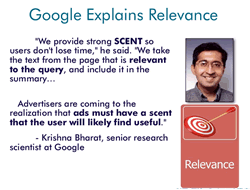
Marketing optimization expert Bryan Eisenberg often refers to what he calls the “Holy Trinity of Conversion Optimization”.
When going through one of the presentations Bryan gave at an edition of our Fusion Marketing Experience events, it struck me how related his conversion trinity is to what we often talk about in content marketing and some lessons content marketers can learn from it.
Bryan Eisenberg has been covering his trinity of conversion optimization often. With the “Holy Trinity”, Bryan combines his long conversion optimization experience in a kind of ‘formula’ which is in a way a reminder and guide for marketers to optimize their conversion, irrespective of the online property and channel.
That’s not an unnecessary luxury if you know that Bryan Eisenberg defined over 1,100 parameters that influence conversion in the first book he wrote with his brother Jeffrey.
The lessons in these first books are still very relevant as you’ll notice. I can’t repeat enough how much younger generations can learn from classics such as the books of Bryan, Gerry McGovern (also a previous speaker and conversion and customer experience expert who knows the power of words and content) and many more.
Bryan summarized the over 1,100 parameters that influence conversion in the three essential questions below you should ask yourself. An overview and a few promised content marketing lessons.
Relevance: do you have what I am looking for?

The first is relevance. It seems like a vague word, but it isn’t. After all, the question that every marketer should ask is whether or not what he is doing is relevant to what people are “looking” for, what they like, what sticks with them, what they crave, you name it.
Bryan also relates relevance to what he calls “scent” and in a presentation he gave at a previous edition of the Fusion Marketing Experience defined it using Google’s words as you can see in the screenshot on the right-hand side.
It’s really a customer-centric message that looks similar to that of another Fusion Marketing Experience speaker, Gerry McGovern. Gerry regularly points out that, as a marketer, you should always know the top tasks that people want to perform on your website (or any other property).
Ask yourself: is what you are doing relevant for the objectives of the people with whom you want to interact when they want, both in a direct or indirect way? And, even go further. As Bryan says: be more than relevant, be remarkable. It’s something we hear a lot in content marketing too: quality, relevance and pertinence trump all the rest.
Or as Content Marketing Conference 2014 speaker Jay Baer puts it when talking about relevance in our interview on Youtility, usefulness and true customer value: “Today, when consumers have all the power in the messaging equation, without relevancy you have nothing”.
Want to know if your content is valuable enough? Challenge yourself and ask yourself if they would be willing to pay something for it – Jay Baer
Value: why would I do business with you?
The second dimension is value. As a company you obviously want to reach something as well. Offering people information they seek/want is just one step.
In a truly integrated content marketing plan it’s in fact the first thing to do. If you want further interaction, it is very important to know your ‘Online Value Proposition’. In other words: is it clear to people why they should do business with your company and is it immediately visible to what extent you are different from your competitors?
Bryan once used a great way to have attendees of our Fusion Marketing Experience think about their value and online value proposition (or even value proposition in general) in his marketing optimization fitness plan workshop: try saying it in a tweet. Silence guaranteed by worth doing the exercise!
In fact, there is a link between the ‘Online Value Proposition’, content marketing and also branding. In our interview with Ardath Albee, she explains what she calls “the company’s distinct value, defined as the intersection of a company’s strengths with customer needs“ as part of a buyer-centric content marketing strategy.
Or think about what Joe Pulizzi says about having a “content marketing mission statement“: “without a ‘formidable why, epic content marketing is impossible“.
See the similarities with Bryan’s value proposition? And with relevance? Finally, from the brand perspective I just love what Content Marketing Conference speaker Doug Kessler says when talking about content marketing, “obsessive empathy” and taking a stand as a brand with content marketing in our interview.
It’s about distinct value, the value proposition and even about more: empathy and deep understanding: “content can only hit the spot if it comes from an intimate understanding of the reader (or viewer) – her goals, problems, challenges and biases“. That’s customer-centricity and it should be more than just a promise instead of a reality as is still too often the case.
Call-to-action:do you make it easy for me?
The third dimension is the call-to-action. In any content marketing program this begins with not standing in the way of what people want to do/know and make it easier using, again the word, ‘relevant’ content.
We often look at the call-to-action as a way to convince people to act but the question is what they need in order to find what they seek and act, and how we make it easy for them to do so.
This is why I always say that inbound marketing, for instance, is not about being found, but about enabling people to find what they are looking for.
In general, marketing is becoming more than facilitating great customer experiences and customer/audience choice, even if brands still have more control than we sometimes like to think. In the words of Steve Krug’s famous usability book, ‘Don’t Make Me Think’. Indeed, don’t make them think. Or, maybe even better: make them enjoy the ride and the whole customer experience, whatever the touchpoint or intent. And that goes for content too, no matter the goals you want it to serve.
Again, it’s a very customer-centric viewpoint (and you should think from the perspective of the “other” such as the customer) that resembles what Gerry McGovern says about the already mentioned top tasks. Ensure that you make it possible and easy to perform them and avoid all potential obstacles towards completion of the top tasks.
And to achieve it, know your customers and audiences, learn the principles of persuasion/influence, persuasive content, carewords, scent, relevance, value and – last but not least – get out of the siloed approach we’ve been talking about so often and Rober Rose emphasized in our interview in the context of content marketing and customer experiences.
See? In the end it’s all connected. That’s what customer-centric and integrated digital marketing is all about. And that’s where content marketing truly comes in.


